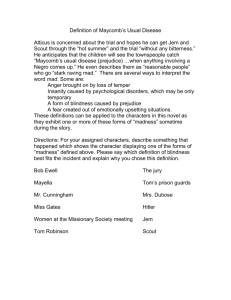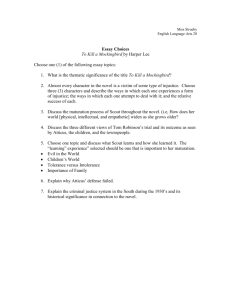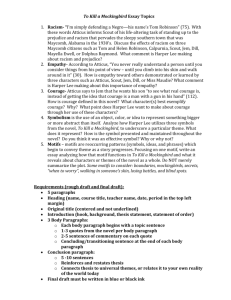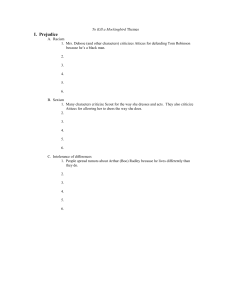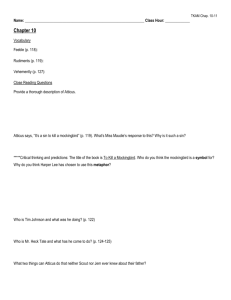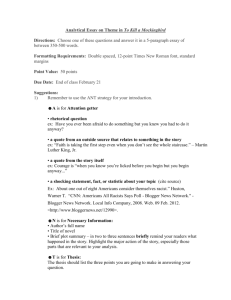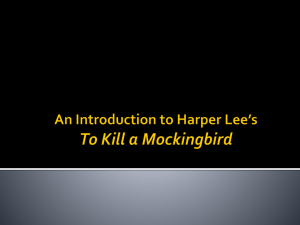study guide.doc - englishwithamos
advertisement
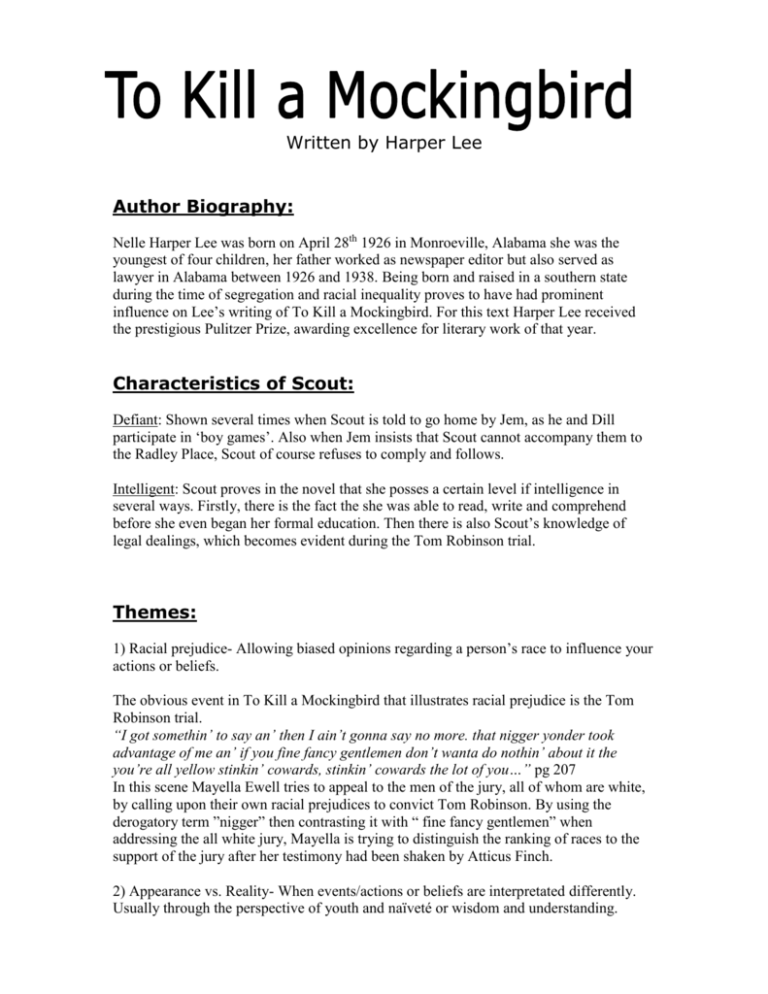
Written by Harper Lee Author Biography: Nelle Harper Lee was born on April 28th 1926 in Monroeville, Alabama she was the youngest of four children, her father worked as newspaper editor but also served as lawyer in Alabama between 1926 and 1938. Being born and raised in a southern state during the time of segregation and racial inequality proves to have had prominent influence on Lee’s writing of To Kill a Mockingbird. For this text Harper Lee received the prestigious Pulitzer Prize, awarding excellence for literary work of that year. Characteristics of Scout: Defiant: Shown several times when Scout is told to go home by Jem, as he and Dill participate in ‘boy games’. Also when Jem insists that Scout cannot accompany them to the Radley Place, Scout of course refuses to comply and follows. Intelligent: Scout proves in the novel that she posses a certain level if intelligence in several ways. Firstly, there is the fact the she was able to read, write and comprehend before she even began her formal education. Then there is also Scout’s knowledge of legal dealings, which becomes evident during the Tom Robinson trial. Themes: 1) Racial prejudice- Allowing biased opinions regarding a person’s race to influence your actions or beliefs. The obvious event in To Kill a Mockingbird that illustrates racial prejudice is the Tom Robinson trial. “I got somethin’ to say an’ then I ain’t gonna say no more. that nigger yonder took advantage of me an’ if you fine fancy gentlemen don’t wanta do nothin’ about it the you’re all yellow stinkin’ cowards, stinkin’ cowards the lot of you…” pg 207 In this scene Mayella Ewell tries to appeal to the men of the jury, all of whom are white, by calling upon their own racial prejudices to convict Tom Robinson. By using the derogatory term ”nigger” then contrasting it with “ fine fancy gentlemen” when addressing the all white jury, Mayella is trying to distinguish the ranking of races to the support of the jury after her testimony had been shaken by Atticus Finch. 2) Appearance vs. Reality- When events/actions or beliefs are interpretated differently. Usually through the perspective of youth and naïveté or wisdom and understanding. This theme is shown in chapter 15 with the Finch residence is visited by a group of gentlemen. These men, unlike the mob later met, are friends of Atticus who have merely come to inform him that Tom Robinson is being moved. Jem, however interprets this late night meeting as a warning to Atticus as he says “They were after you, weren’t they…they wanted to get you, didn’t they?” pg161. Atticus then relies to Jem that they were his friends although Jem still remains uncertain. The theme of appearance vs. reality is also apparent when the Finches find themselves in a similar situation, the only difference being that the newly assembled mob is not their friends. These people have come to abuse and intimidate Tom Robinson who was being detained in a Maycomb county cell. Now, it is Scout who perceives things differently from reality. Scout does not seem to comprehend that these men are apart of a lynch mob, as she engages herself in a conversation with Mr. Cunningham, and is oblivious to the hostile mood. Setting Where: Maycomb County (fictitious), Alabama When: Approx 1930s The setting of the novel supplied much of the plot and encouraged the growth of themes. Being set in a southern state (Alabama) during the times of racial predjuice and segregation it allowed for Atticus’ defense of Tom Robinson to be seen as a major conflict and cause tension and hostility to arise. Quotes describing Maycomb: “Maycomb was an old town, but it was a tired old town when I first knew it. In the rainy weather the streets turned to red slop; grass grew on the sidewalks, the court-house sagged in the square.” pg 5 “The Radley Place jutted into a sharp curve beyond our house. Walking south, one faced its porch; the sidewalk turned and ran beside the lot. The house was low, was white with a deep front porch and green shutters, but had long ago been darkened to the colour of the slate-grey yard around it. Rain-rotten shingles drooped over the eaves of the veranda; oak trees kept the sun away. The remains of a picket drunkenly guarded the front yard- a ‘swept’yard that was never swept- where johnson grass and rabbit-tobacco grew in abundance.” pg 9 Scout describes Maycomb as being so small that her family, the Finches, are "related by blood or marriage to nearly every family in the town." Beginning and End In the beginning of the novel To Kill a Mockingbird we are lead by our narrator, Scout, as she begins an informative overview of the small town she lives in, Maycomb. Refer to setting quotations for detailed description. The conclusion of the novel is quite interesting in the respect that it not only links the beginning to it but the novel as a whole. This concept can be better identified with the narration given by Scout on pages 307 to 308. This is where Scout retells the main occurrences of the novel but it seems she does so from the perspective of Mr. Authur Radley (Boo). This relates to the advice given by Atticus to his daughter in regards to other people’s perception of thing, “You never really understand a person until you consider things from his point of view - until you climb into his skin and walk around in it.” Another minor link the beginning of the novel makes to the end if a reference to Jem’s broken arm: “When he was nearly thirteen my brother Jem got his arm broken badly at the elbow.” pg 1 This fracture Scout is referring to was obviously the one that Jem sustained whilst being attacked by Robert Ewell.


